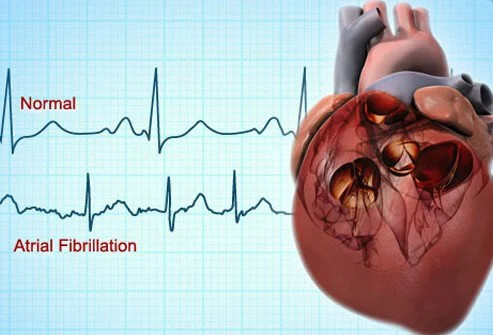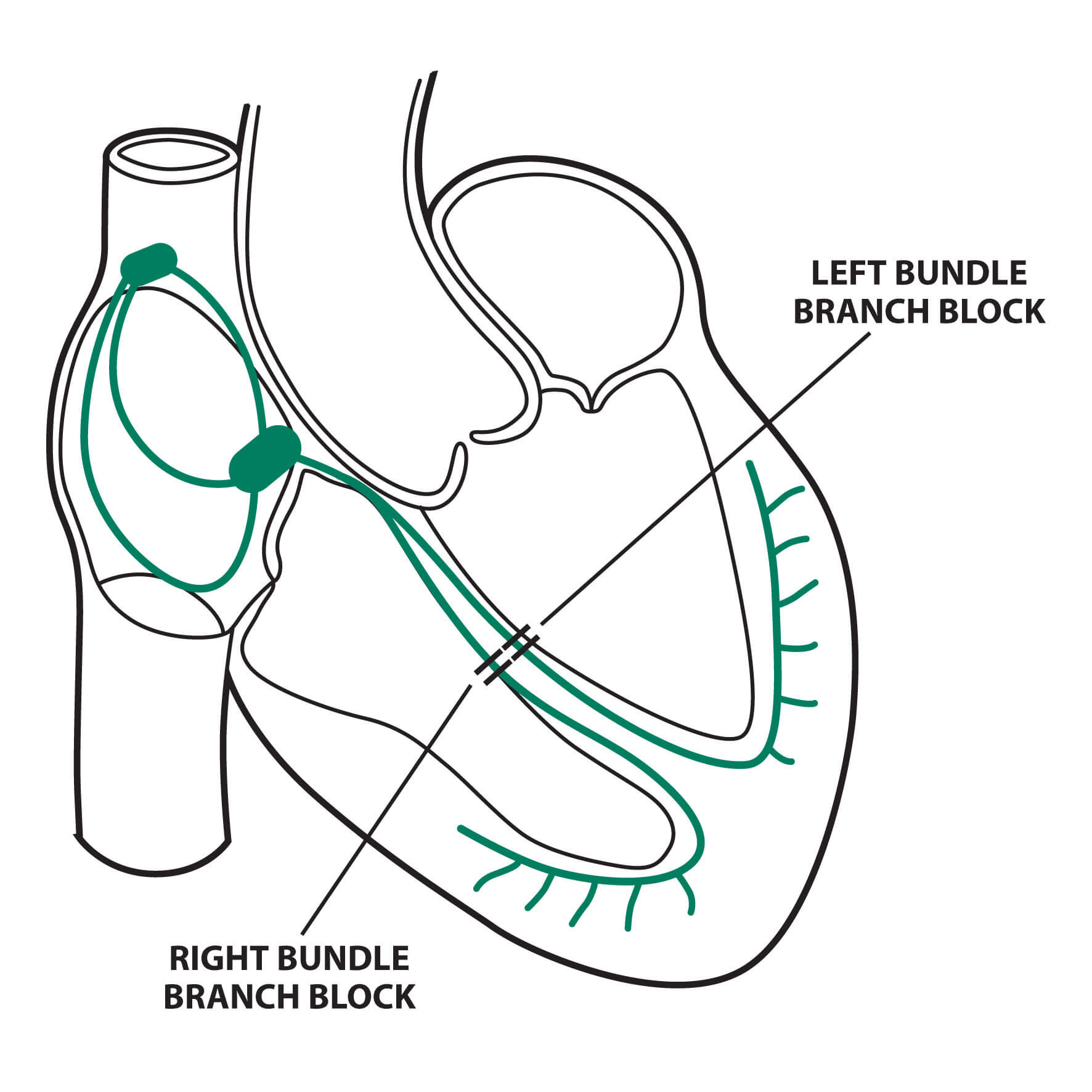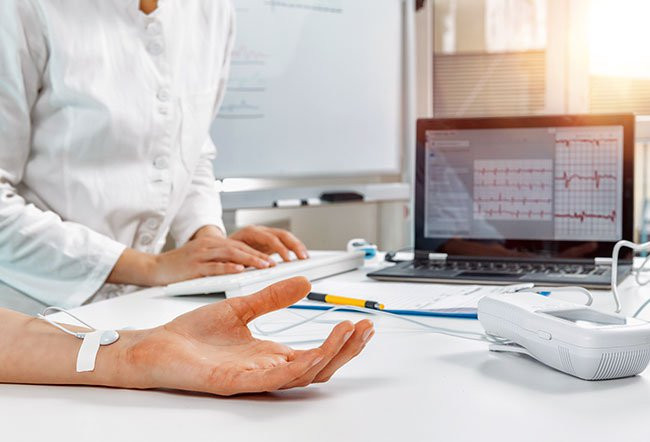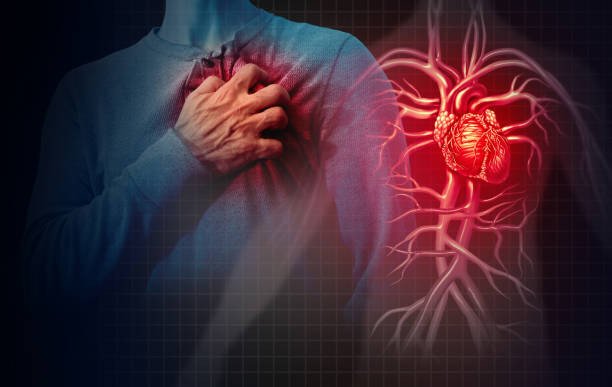Definisi
Fibrilasi atrial (AFib) adalah salah satu kelainan ritme jantung yang paling sering terjadi. Kelainan ritme jantung merupakan kondisi ketika jantung berdenyut terlalu cepat, terlalu lambat, atau tidak teratur. Pada fibrilasi atrial, kedua serambi kanan dan kiri jantung berdenyut tidak teratur, sehingga aliran darah terganggu. Fibrilasi atrial dapat terjadi dalam episode/kejadian singkat atau terjadi sebagai kondisi permanen.
Penyebab
Jantung memiliki empat kamar: dua serambi dan dua bilik. Pada serambi kanan, terdapat sekelompok sel yang disebut sebagai nodus sinus. Nodus sinus merupakan alat pacu jantung alami. Nodus sinus menghasilkan sinyal yang memulai setiap denyut jantung. Pada ritme jantung yang normal, sinyal dari nodus sinus akan berjalan menuju kedua serambi. Selanjutnya, sinyal tersebut berpindah dari serambi ke bilik melalui nodus atrioventrikuler (AV). Pergerakan sinyal ini menyebabkan jantung berkontraksi, sehingga dapat memompa darah ke paru, otot-otot jantung, dan seluruh tubuh.
Pada fibrilasi atrial, sinyal pada kedua serambi mengalami kekacauan. Akibatnya, kedua serambi tidak dapat berkontraksi dengan baik, melainkan hanya bergetar saja. Tidak hanya itu, nodus AV dipenuhi oleh sinyal dari serambi yang hendak berjalan ke bilik. Sinyal-sinyal inilah yang menyebabkan ritme jantung menjadi cepat dan tidak teratur. Denyut jantung pada fibrilasi atrial dapat berkisar antara 100-175 kali/menit, sementara denyut jantung normal berkisar antara 60-100 kali/menit.
Faktor Risiko
Risiko fibrilasi atrial meningkat akibat:
- Semakin tua usia seseorang, semakin tinggi pula risiko untuk terjadi fibrilasi atrial
- Penyakit jantung. Semua orang dengan penyakit jantung (seperti gangguan katup, penyakit jantung bawaan, gagal jantung, penyakit jantung koroner, atau riwayat serangan jantung atau operasi jantung) memiliki risiko fibrilasi atrial yang lebih tinggi
- Tekanan darah tinggi. Tekanan darah tinggi yang tidak terkontrol dengan obat-obatan serta perubahan gaya hidup dapat meningkatkan risiko fibrilasi atrial
- Penyakit tiroid. Pada sebagian orang, masalah tiroid dapat memicu gangguan ritme jantung, termasuk fibrilasi atrial
- Kondisi kesehatan kronis lainnya. Orang-orang dengan kondisi kronis tertentu seperti diabetes, sindrom metabolik, gagal ginjal kronik, penyakit paru, atau mengorok memiliki risiko lebih tinggi untuk mengalami fibrilasi atrial
- Konsumsi alkohol. Pada beberapa orang, konsumsi alkohol dapat memicu episode fibrilasi atrial
- Obesitas. Orang dengan berat badan berlebih memiliki risiko lebih tinggi untuk mengalami fibrilasi atrial
- Riwayat keluarga. Beberapa keluarga lebih rentan mengalami fibrilasi atrial dibandingkan dengan keluarga lainnya
Gejala
Sebagian orang dengan fibrilasi atrial tidak merasakan gejala apapun. Gejala yang dapat muncul pada fibrilasi atrial berupa:
- Sensasi denyut jantung yang cepat dan berdegup kencang (palpitasi)
- Nyeri dada
- Pusing
- Lelah
- Kepala terasa ringan atau melayang
- Tidak dapat beraktivitas terlalu berat
- Napas pendek
- Lemah
Tipe kemunculan fibrilasi atrial adalah sebagai berikut:
- Muncul pada saat tertentu (paroksismal). Gejala fibrilasi atrial pada tipe ini hilang timbul, biasanya bertahan beberapa menit hingga jam. Gejala dapat bertahan selama seminggu dan episode ini dapat berulang. Gejala juga dapat hilang dengan sendirinya. Beberapa penderita fibrilasi atrial tipe ini membutuhkan terapi
- Persisten. Pada tipe ini, ritme jantung tidak kembali normal dengan sendirinya. Jika penderita tipe ini mengalami gejala fibrilasi atrial, ia memerlukan kardioversi (koreksi ritme jantung dengan kejut listrik) atau obat-obatan untuk mengembalikan ritme jantung yang normal
- Persisten lama. Fibrilasi atrial tipe ini berlangsung terus-menerus dan bertahan selama lebih dari 12 bulan
- Permanen. Pada tipe ini, ritme jantung yang tidak teratur tidak dapat dikembalikan seperti semula. Oleh karena itu, tipe ini perlu dikontrol dengan obat-obatan yang menjaga denyut jantung dan mencegah terbentuknya bekuan darah.
Diagnosis
Fibrilasi atrial dapat terdeteksi dari pendengaran bunyi jantung. Selanjutnya, beberapa pemeriksaan dapat dilakukan. Pemeriksaan dapat berupa elektrokardiografi (EKG), yaitu sebuah pemeriksaan untuk mendeteksi aliran listrik pada jantung. Selain pemeriksaan EKG, pemeriksaan biomarker dan pencitraan dapat pula dilakukan. Biomarker merupakan zat tertentu yang berubah kadarnya saat ada kerusakan organ, salah satunya jantung. Sementara itu, pencitraan yang dapat dilakukan berupa rontgen dada. Pemeriksaan biomarker dan pencitraan dilakukan untuk menemukan kemungkinan penyebab fibrilasi atrial, misalnya gagal jantung.
Tata Laksana
Fibrilasi atrial seringkali bukanlah situasi yang mengancam nyawa, namun dapat menyebabkan ketidaknyamanan dan membutuhkan terapi karena memiliki komplikasi yang berpotensi mengancam nyawa. Terapi untuk fibrilasi atrial dapat melibatkan obat-obatan untuk mencegah stroke, karena orang dengan fibrilasi atrial jauh lebih rentan untuk mengalami stroke. Selain itu, obat-obatan juga diberikan untuk mengontrol ritme dan denyut jantung. Pada kondisi tertentu, kardioversi dapat dilakukan. Kardioversi merupakan kejut listrik yang dilakukan untuk mengoreksi ritme jantung. Apabila kondisi sudah sangat parah, Anda dapat disarankan untuk menjalani ablasi kateter. Ablasi kateter merupakan suatu tindakan yang dilakukan untuk menghancurkan bagian jantung yang menyebabkan gangguan ritme jantung dengan gelombang radiofrekuensi. Setelah menjalani tindakan ini, Anda mungkin akan disarankan untuk memakai alat pacu jantung untuk membantu jantung Anda berdenyut dengan normal.
Komplikasi
Fibrilasi atrial terkait dengan peningkatan risiko kematian akibat kejadian penyumbatan pembuluh darah karena bekuan darah, misalnya stroke. Hal ini terjadi karena fibrilasi atrial menyebabkan aliran darah menjadi tidak lancar, sehingga darah menumpuk pada serambi jantung dan membentuk bekuan darah. Pada suatu saat, bekuan darah ini dapat lepas dari jantung dan menyumbat pembuluh darah lainnya. Salah satu pembuluh darah yang sering menjadi sasaran adalah pembuluh darah otak, sehingga gejala yang muncul dapat berupa stroke. Risiko stroke meningkat seiring dengan usia. Selain itu, faktor risiko stroke lainnya berupa tekanan darah tinggi, diabetes, gagal jantung, dan gangguan katup jantung.
Pencegahan
Pencegahan fibrilasi atrial dapat berupa perubahan gaya hidup. Perubahan gaya hidup ini dapat berupa:
- Makan makanan bergizi, kaya sayur dan buah, rendah lemak dan kolesterol. Jika Anda memiliki tekanan darah tinggi, mengurangi konsumsi garam dapat membantu tekanan darah Anda tetap normal. Anda juga dapat berkonsultasi dengan dokter atau ahli gizi untuk mengatur diet Anda sehari-hari
- Menjaga berat badan ideal dengan berolahraga teratur. Olahraga yang disarankan adalah olahraga dengan intensitas sedang, seperti senam aerobik, jogging, bersepeda, atau berenang. Olahraga disarankan untuk dilakukan minimal 30 menit/hari, 3-5 kali/minggu
- Tidak merokok. Jika Anda merokok, Anda dapat bertanya pada tenaga kesehatan mengenai program berhenti merokok
- Menghindari atau membatasi konsumsi alkohol dan kafein
- Menghadapi stres, karena stres dan marah dapat menyebabkan masalah ritme jantung
Kapan Harus ke Dokter?
Jika Anda merasa ada tanda-tanda fibrilasi atrial, Anda dapat berkonsultasi dengan dokter. Namun, jika Anda merasakan nyeri dada, Anda mungkin perlu untuk ke IGD terdekat karena nyeri dada dapat disebabkan oleh serangan jantung, yang dapat mengancam nyawa. Anda juga dapat berkonsultasi dengan dokter apabila Anda memiliki denyut jantung yang konsisten di bawah 60 kali/menit atau di atas 100 kali/menit, terutama apabila disertai dengan pusing dan napas pendek. Tanda dan gejala ini dapat menjadi petunjuk adanya gangguan ritme jantung.
Mau tahu informasi seputar hasil pemeriksaan laboratorium, radiologi, dan lainnya? Cek di sini, ya!
- dr Anita Larasati Priyono
Atrial fibrillation. (2021). Retrieved 11 April 2022, from https://www.nhs.uk/conditions/atrial-fibrillation/
Atrial fibrillation - Symptoms and causes. (2021). Retrieved 11 April 2022, from https://www.mayoclinic.org/diseases-conditions/atrial-fibrillation/symptoms-causes/syc-20350624
Rosenthal, L. (2019). Atrial Fibrillation: Practice Essentials, Background, Pathophysiology. Retrieved 11 April 2022, from https://emedicine.medscape.com/article/151066-overview











